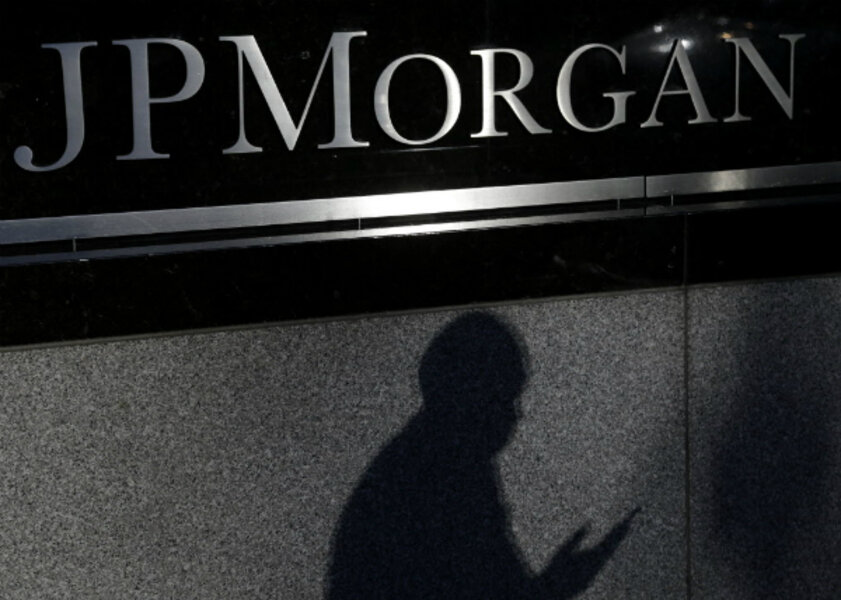JPMorgan Chase settles. Is $13 billion for role in mortgage crisis fair?
Loading...
| NEW YORK
In a single deal dwarfing any other in American history, the US Justice Department announced a $13 billion civil settlement with JPMorgan Chase Tuesday – restitution stemming from the bank’s questionable mortgage-bundling practices that helped plunge the country into the Great Recession.
The mammoth agreement follows months of negotiations between the government and the nation’s largest bank, which currently holds about $2.4 trillion in assets. It also closes the docket of a number of state and federal lawsuits that challenged JPMorgan’s sale of mortgage-backed securities that devastated pension funds and other investors around the world before the economy crashed in 2008.
“Without a doubt, the conduct uncovered in this investigation helped sow the seeds of the mortgage meltdown,” said Attorney General Eric Holder in a statement. “JPMorgan was not the only financial institution during this period to knowingly bundle toxic loans and sell them to unsuspecting investors, but that is no excuse for the firm’s behavior. The size and scope of this resolution should send a clear signal that the Justice Department’s financial fraud investigations are far from over. No firm, no matter how profitable, is above the law, and the passage of time is no shield from accountability."
The agreement also includes a “statement of facts” in which JPMorgan admitted that its employees were well aware that the mortgages it sold did not comply with standard underwriting guidelines – and then misled investors by bundling mortgages in securities they knew were hardly fit for sale.
JPMorgan agreed to pay $4 billion to struggling homeowners harmed by the company’s unlawful conduct, according to the agreement. Of this amount, as much as $1.5 billion will be used to pay down some of the principal for “underwater” homeowners who owe more than their houses are worth. And $300 million or more will be used for mortgage forbearance, which restructures loans to reduce homeowner’s monthly payments.
The other $2 billion in consumer restitution will be used for other consumer relief measures, including taking on amounts owed on vacated homes, lowering interest rates on existing homes, or helping lower-income borrowers secure new loans. According to the agreement, some of this money can also be directed toward anti-blight measures in devastated residential areas, including the demolition of abandoned, run-down homes in places like Detroit.
JPMorgan is also required to hire an independent monitor to oversee these consumer measures, which must be completed by 2016 – otherwise, additional penalties will kick in.
The company will also shell out $9 billion more to settle the claims in a number of state and federal complaints, including a previously announced $4 billion settlement with the Federal Housing Finance Agency (FHFA). The agency oversees the government-sponsored Fannie Mae and Freddie Mac, which purchased many of the fraudulently sold securities.
“In terms of size, these are staggering settlements, by any historical measure that I’m aware of,” says Robert Kaplan, former vice chairman at Goldman Sachs and now a professor and dean at the Harvard Business School. “The mortgage business is a massive, massive market – it touches millions and millions of consumers, and that’s why penalties for wrongdoing in this segment are going to be very large.”
The settlement does not, however, release any individuals within JPMorgan from further criminal or civil charges. The bank has agreed to cooperate fully in any investigations related to the fraud covered in the agreement.
“I think that the Department of Justice has heard the public in terms of saying, if people were criminally responsible, they should be held liable,” says David Reiss, a professor at Brooklyn Law School, who has written extensively on the mortgage crisis. “Just a handful of people have faced any serious personal liability as a result of the events of the financial crisis of the 2000s.”
But some feel that the unprecedented scope and size of the penalty is unfair for the bank behemoth, which was seen as something of a financial savior when it took on the imploding assets of Bear Stearns and Washington Mutual after the financial collapse. Some estimate that employees at these banks conducted up to 80 percent of the fraud found by the Justice Department. JPMorgan assumed these firms' legal jeopardy when it took on their troubled assets.
“There’s a moral narrative about this, that it’s unfair to go after JPMorgan because they stepped in to help,” says Mr. Reiss.
“I think privately, I’m sure people at JPMorgan feel – and certainly people on Wall Street feel, rightly or wrongly – that this is unfair,” says Mr. Kaplan.
But in the end, acquiring these assets may have helped rather than hurt the once well-respected bank, even though it has taken such a hit to its reputation and bottom line. The $13 billion settlement represents only a drop in its massive multi-trillion holdings, and only about half of its 2012 net income of $21.3 billion – a record-setting year that made it one of the most profitable US banks last year.
“We are pleased to have concluded this extensive agreement,” said JPMorgan’s chief executive James Dimon, in a statement. He also noted that the firm has already reserved funds for the settlement, which “terminates all pending civil enforcement investigations” into its residential mortgage securities.
And financial analysts say the settlement will only help the bank as it moves forward.
“It’s a huge amount of money obviously, and it obviously reduced their net worth when they made the reserve,” says Kaplan. “But having said that, they’re still well capitalized, they can still manage it, and the reality is, JPMorgan from here will be evaluated on their ability to generate earnings.”
“And this takes a real overhang off the table that might have jeopardized their ability to generate earnings in the future,” he says.







